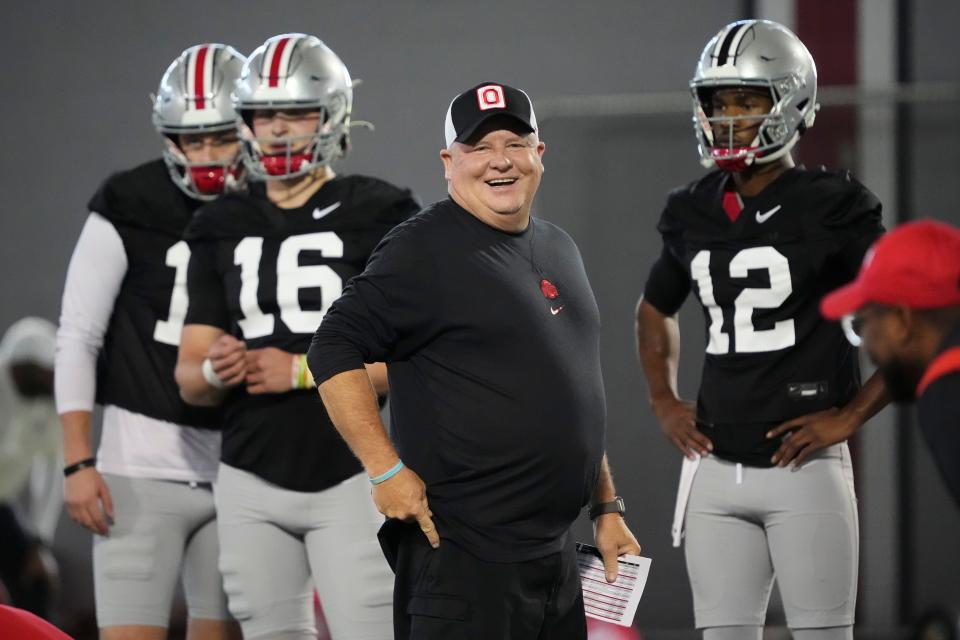Oller's Second Thoughts: Big Ten, SEC trying to run college football into playoff iceberg
At approximately 2:05 a.m. on April 15, 1912, Thomas Andrews was spotted standing alone in the first-class smoking room of the Titanic, arms folded, life belt lying on a nearby table.
Andrews, the naval architect who had helped design the suddenly doomed ocean liner, did not respond when a steward asked, “Aren’t you going to have a try for it, Mr. Andrews?”
Whether contemplating his fate or frozen in shock over the inevitable end of his “unsinkable” masterpiece, no one knows. Andrews went down with the ship, one of more than 1,500 passengers who died that frigid night in the North Atlantic.
No loss of life is tied directly to the sea change happening in college football, but fans cannot be blamed if, like Andrews, they stare blankly into the scene, stunned and saddened by events impacting a game that is collapsing and sinking fast.
More Rob Oller: Oller's Second Thoughts: Ohio State quarterback room crowded but cool, at least so far

And now comes another iceberg warning that may go unheeded. Except that unlike NIL and the transfer portal, which were unavoidable as the courts cry “Full steam ahead,” the latest obstacle can be navigated around. But if not, it may be the most damaging of all.
Raise your binoculars to the horizon and what you see is the Big Ten and SEC bucking for preferential treatment by each wanting to be guaranteed of getting three teams in what could become a 14-team playoff in 2026.

And if that happens, well, head for the lifeboats, people, because college football as we know it is sunk. Key phrase: as we know it. The game will remain popular, still attract fans to stadiums and viewers to TVs, but it will be different. As in worse.
Drawing a line in the sand that cannot or should not be crossed probably is an act of futility, because money matters more than anything, and the Big Ten and SEC have and want and think they deserve more of it than anyone else.
I’m not opposed to the two conferences benefiting more than their counterparts in the ACC and Big 12, but let the advantages be about money, not playoff promises.
At issue is the cheapening of the regular season. What sets college football apart from the NFL, at least at the elite level where Ohio State and a dozen other programs do business, is the unofficial “one-and-done” rule. Lose one game and your national championship hopes may be/probably are finished. In that way, the entire regular season is a playoff, with the non-conference games serving as “byes” and the conference schedule acting as a minefield that must be crossed before reaching rivalry week.
Expanding the four-game playoff to 12 teams diluted the regular season a little, but guaranteeing the Big Ten and SEC three teams apiece – the gluttons originally pushed for four – absolutely rinses it by reducing the pain, suffering and chaos that comes each week during a 12-game regular season.
Losing to Appalachian State or Akron – Ohio State’s Aug. 31 opener – should cripple if not automatically kill a Power Five school’s season. But if you know the CFP has reserved three spots for your conference, those losses lose much of their sting.
Keeping the argument specific to Ohio State, the Buckeyes have the brand and cache to lose two games and make a 12-team playoff. A 14-team playoff, with three Big Ten teams assured of making the field, means OSU is a playoff lock even if losing three games. In other words, without earning it.
More: Oller's Second Thoughts: Time to put halt to court storming before serious injury occurs
Some wonder what the fuss is. The Buckeyes have not lost three games in a regular season since 2011, when the program was recovering from the forced resignation of Jim Tressel. Before that, the last three-loss regular season was 2004, so arguing against “automatic” playoff entry is almost moot to the discussion.
Almost, but not quite. College football thrives on controversy – weekly rankings, CFP committee chaos – and is fueled by a weekly fear of failure. Tear away at that foundational fabric by guaranteeing three playoff spots and two top seeds that would come with byes, which the Big Ten and SEC are pushing for, and you gut the sport.
Again, it’s about money and power. The Big Ten and SEC have the bulk of both. But with great resources comes great responsibility. Taking care of your own is all well and good, but when it negatively impacts the game itself? The smokestacks topple and the lifeboats float away

Titanic II: the PGA Tour needs rescuing
I’m not a LIV Golf guy. Tried to watch it again last week, saw Jon Rahm wearing shorts, and changed the channel.
But before accusing me, somewhat accurately, of joining old man Muppets Statler and Waldorf by weighing in from the balcony, consider that of late I haven’t been much of a PGA Tour guy, either. In that way, I’m an equal opportunity crank.
My issue with the tour is the best players bring no buzz. If LIV players such as Rahm lack character – it sickens me how the Spaniard has backtracked on many of his original anti-LIV beliefs – the tour lacks characters.
Enjoyed this from Cantlay yesterday. pic.twitter.com/0Uhjv21QFO
— Kyle Porter (@KylePorterCBS) March 6, 2024
Pros who have interesting things to say off the course, like Patrick Cantlay, too often are dull or unlikeable between the ropes. Scottie Scheffler would be a nice next-door neighbor, but he doesn’t bring much personality to the backyard barbecue party. Rory McIlroy can be salty, but his moodiness means you can never count on the spice. And so on and so forth.
Put it this way: The Tour is lucky it has Tiger Woods to create curiosity, although the increasingly worn story line of “Will he play this week?” works only so long.
LIV, meanwhile, is dotted with pros whose actions speak softer than their words. The exhibition tour is interesting mostly because it has players who, though past their prime, know how to talk a good game even if they don’t play it. That is changing a bit with the addition of Rahm, and Brooks Koepka remains a threat to win majors just by falling out of bed, but the most recognizable names remain guys such as Phil Mickelson, Dustin Johnson and Bubba Watson, whose careers are in the sunset years.
I’m not sure how the Tour better captures the attention of fans who are tuning out – the fall series TV ratings were underwhelming – other than promote the heck out of fun players such as Viktor Hovland and Max Homa … and hope Tiger wins the Masters.

Listening in
“We’re all teachers. Education is the transportation of knowledge, so it doesn’t matter what the coach knows. It matters what the players understand. It’s what they know that ultimately is going to win games, not what we know.” – Ohio State offensive coordinator/quarterbacks coach Chip Kelly.

Off-topic
Do yourself a favor and sit down with a World War II veteran or someone who lived through the war years to hear what life was like at that time. And, after receiving permission, either jot down or record their stories. But mostly just listen. It means a lot to them and will enrich you.
Get more Ohio State football news by listening to our podcasts
This article originally appeared on The Columbus Dispatch: Oller's Second Thoughts: College football heads toward iceberg thanks to Big Ten, SEC
